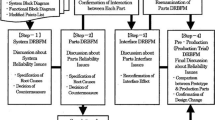Abstract
Failure of products in service under foreseeable conditions often subject manufacturers to legal liability when personal injuries occur; hence, the care used (or the philosophy employed) in material selection, design, analyses, fabrication and maintenance must be sufficient to preclude failure. Failure analysis requires careful sorting of a wide variety of information to determine how and why a metal part failed in service or in testing and to determine what can be done to prevent a recurrence. Valuable knowledge is available in the literature from documentation of prior failures that may be used to develop logical approaches to the design and development of new components. A philosophy of design and prototype evaluation based on the prevention of failure is more sound and workable than the stereo-typed application of empiricisms, codes, specifications and factors of safety now commonly used. Reliance on design for static loadings and for factors of safety based on tensile strength as a criterion are frequently erroneous and dangerous. If a part does not fulfill its intended function satisfactorily, it “fails” by: (a) excessive deformation, (b) fracture, (c) surface disintegration, and (d) deterioration of properties. A variety of failures will be discussed to emphasize the factors that must be considered in selection of an optimum material and in prescribing an effective method of simulated-service testing. Considerable latitude in use and misuse of equipment must be foreseen in order to predict possible modes of failure. A broad consideration of service environment is necessary for correcting faulty design and selecting proper materials which will withstand modifications due to processing, fabrication, maintenance or repair operations that lead to failure.
Similar content being viewed by others
References
Robb, D. A., Philo, H. andGoodman, R. M., The Lawyers Desk Reference, Lawyers Co-op Pub. Co., Rochester, N. Y. (1966).
Reports of Special ASTM Committee E-24 on Fracture Testing of Metallic Materials: First Report—”Fracture Testing of High-Strength Sheet Materials: A Report of A Special ASTM Committee,” ASTM Bulletin 29–40 (January, 1960) 244, 18–28 (February, 1960). See also subsequent reports in Materials Research & Standards, 389–393 (May, 1961), 877–885 (November, 1961) and 107–118 (March, 1964).
“Fracture Toughness Testing and Its Applications,” ASTM STP 381 (1965). See also: ASTM STP 410 (1967).
“Control of Steel Construction to Avoid Brittle Failure,” Plasticity Committee, Welding Research Council (1957).
Shank, M. E., “Brittle Failure in Carbon Plate Steel Structures Other than Ships,” Welding Research Council Bulletin Series No. 17 (January, 1954).
Van Der Sluys, W. A., “Effects of Repeated Loading and Moisture on the Fracture Toughness of S. A. E. 4340 Steel,” Trans. ASME, Series D, 363 (June 1965).
“Fracture of Engineering Materials,” Am. Soc. Metals (September, 1964).
Srawley, J. E. and Esgar, J. B., “Investigation of Hydrotest Failure of Thiokol Chemical Corporation 260-in.-Diameter SL-1 Motor Case,” NASA TMX-1194 (January, 1966).
Copson, H. R., “The Influence of Corrosion on the Cracking of Pressure Vessels,” Welding Jnl. Res. Supp., 75 (February, 1953).
Dolan, T. J., “Simultaneous Effects of Corrosion and Abrupt Changes in Section on the Fatigue Strength of Steel,” Jnl. Appl. Mech. (ASME), A-141 (December, 1938).
“High Pressure Testing—Pipeline Defect Behavior and Pressure Reversals,” ASME preprint 68-PET-24 (1968).
Sines, G. and McLean, E. C., “The Failure of a Welded Drying Drum by Caustic Embrittlement,” Mechanical Engineering, 1105–1109 (December, 1956).
Logan, H. L. and Sherman, R. J., Jr., “Stress-Corrosion Cracking of Type 304 Austenitic Stainless Steel,” Welding Jnl. Res. Suppl., 8 (August, 1956).
Dolan, T. J., “Nonlinear Response Under Cyclic Loading Conditions,”Proc. 9th Midwest Mech. Conf., J. Wiley & Sons, N. Y. (1967).
Morrow, J., “Cyclic Plastic Strain Energy and Fatigue of Metals,” ASTM STP 378 (1965).
ASTM Jnl. of Materials,4 (1) (March,1969)contains four articles on low cycle fatigue, cyclic stress-strain behavior, and the influence of notches (Principal authors: Morrow, Landgraf, Topper, Wetzel).
Langer, B. F., “Design of Pressure Vessels for Low-Cycle Fatigue,” Paper 61-WA-18 ASME (1961).
Jacoby, G., “Fractographic Methods in Fatigue Research,”Experimental Mechanics,5 (3),1–17 (1965).
Longson, J., “A Photographic Study of the Origin and Development of Fatigue Fractures in Aircraft Structures,”Report Structures 267, Royal Aircraft Establishment, Ministry of Aviation, London (March, 1961).
Grigory, S. C., “Studies of the Fatigue Strength of Pressure Vessels,” Southwest Research Foundation, Technical Summary Report SwRI 03-1384, “Fracture Tests of One-Half Scale Model Pressure Vessels,” 134 (April, 1968).
“Failure Analysis of PVRC Vessel No. 5,” Welding Research Council, Bulletin No. 98 (August, 1964).
“Civil Aircraft Accident. Report of the Court of Inquiry into the Accidents to the Comet G,” Her Majesty's Stationery Office, London (1955). See also Bishop, T., “Fatigue and the Comet Disasters,” Metal Progress, 79 (May, 1955).
Cottell, G. A., “Lessons to be Learnt from Failures in Service,” Internatl. Conf. on Fatigue of Metals, ASME-IME, Session 7, Paper 1 (1956).
Wulpi, D. J., “How Components Fail,” Am. Soc. Metals (1966).
Bennett, J. A. and Quick, G. W., “Mechanical Failures of Metals in Service,” Natl. Bureau of Standards, Circular 550 (1954).
Jenks, G. F., “The Interpretation of a Failure of an Ordnance Structure,” presented at the Annual Meeting of ASME (December, 1939).
Samans, C. H., “Results of the Survey of the Study Group on Oil Storage-Tank Failures,”API Proc. Section III,34,143–163 (1954).
“Technical Report,” Vols. IV to VIII, 1965 to 1969, British Engine, Boiler and Electrical Insurance Company, Manchester, England.
Nichols, R. W., “The Use of Overstressing Techniques to Reduce the Risk of Subsequent Brittle Fracture,” British Welding Jnl., 21 (Jan., 1968) and 75 (Feb., 1968).
Moisseiff, L. S., “Investigation of Cold Drawn Bridge Wire,”ASTM Proc.,30,313 (1930).
Mattson, R. L. and Almen, J. O., “Effect of Shot Blasting on Physical Properties of Steel,” Final Report OSRD 3274, 4825, 6647, Washington (1945).
Author information
Authors and Affiliations
Rights and permissions
About this article
Cite this article
Dolan, T.J. Preclude failure: A philosophy for materials selection and simulated service testing. Experimental Mechanics 10, 1–14 (1970). https://doi.org/10.1007/BF02320080
Issue Date:
DOI: https://doi.org/10.1007/BF02320080




